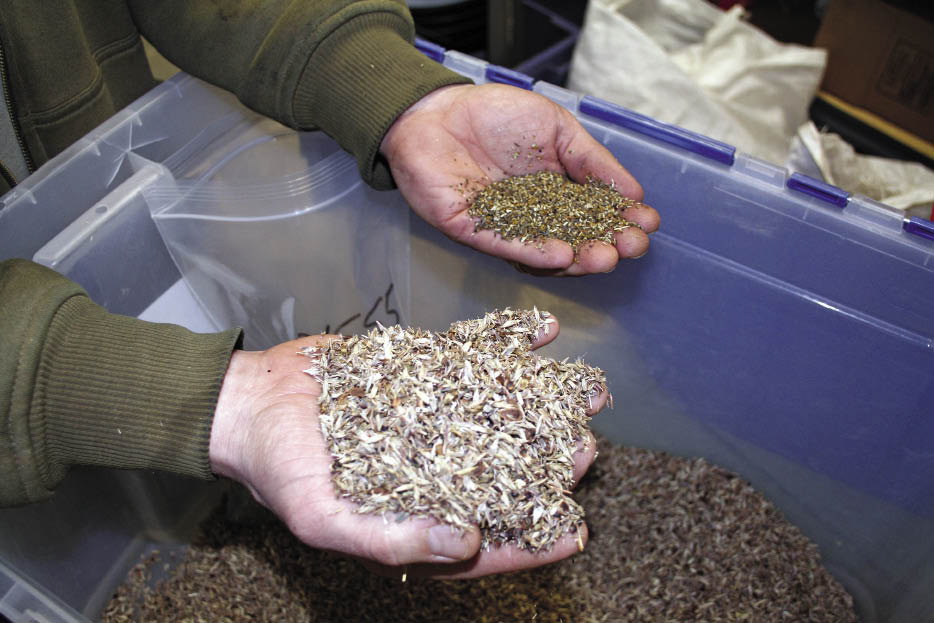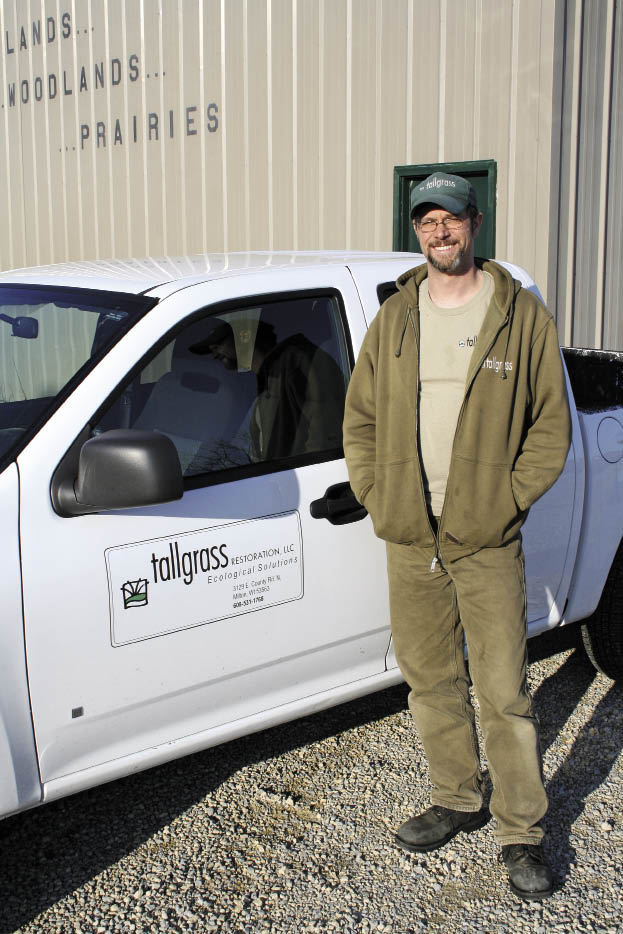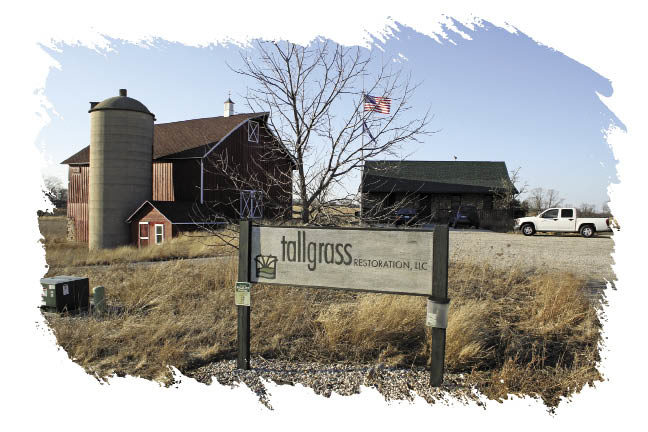Chris Kaplan and a crew of three spent the month of February hauling trees and flood debris from a ravine in rural Wisconsin. Access to the site was so difficult that the team had to mount a winch on their compact tracked loader rather than the grapple bucket they needed for the job. Getting the loader down to the creek wasn’t going to be a problem, but they would have to winch it out.
“We had to walk a fine line between power and accessibility, as we couldn’t get much in there,” says Kaplan, sales and project manager for Tallgrass Restoration. “The creek we were clearing borders private land and many of the access roads had been washed out. We hiked in a lot of hand-held equipment, and even the Bobcat loader was big in many locations.”
The work was performed on frozen ground to minimize disturbance. It also gave the crew a natural deadline — they’d have to be done and out before spring thaw. But the frozen ground also held trees like glue.
“We did a lot of chain sawing and hooking cables around debris and pulling it with a loader,” Kaplan says. “We broke the cable a few times because the load was either too heavy or it was frozen in the ground.”
Tallgrass Restoration, with offices in Schaumburg, Ill., and Milton, Wis., usually installs and maintains natural prairies for corporations and municipalities that want a green alternative to cutting grass, or for farmers with land in a Conservation Reserve Program (CRP). This time of year, their Milton office is busy scheduling spring burn-offs to maintain prairies, a task many landowners leave to the expert.
While the creek job was within its corporate mission — “To restore the health, integrity and beauty of our clients’ land and water resources” — few will ever see the finished product. Several years ago, raging water piled debris and undercut trees along high, sandy banks. The county wanted to prevent further damage should another flood occur.
Making Rural Areas Look ‘Rural’

Native prairie seeds come in a variety of shapes and sizes, which makes planting a challenge without the right equipment.
Basically, the company works to ensure rural areas continue to look “rural.” As an environmental restoration firm, it’s like a professional landscaper but sits in a class all its own due the different jobs they perform, often on very unpredictable terrain. But like a landscape operation, its crews use a variety of equipment — and the gear is worked hard.
The restoration industry doesn’t fall neatly into any category,” says Kaplan. “It’s not landscaping and it’s not farming. A lot of the equipment we use isn’t as tested in the applications we’re putting it in. Farming is a science. Discs and harrows have been tweaked for a hundred years. “But when you get into the work we do such as burning someone’s woods, we’ll piece together different attachments to create something that works for the particular site. A lot of times, things are getting maxed out.”
Tallgrass Restoration is part of the green industry, working to sustainably manage and design a natural landscape. It’s often called environmental restoration or ecological landscaping, the practice has many benefits and is growing in popularity.
The Midwest Ecological Landscaping Assn. (MELA) was founded 10 years ago to “develop and promote standards and best practices for sustainability in the green industry.”
MELA has more than 200 members, says Marilyn Whitney, who handles communication for the Chicago-based group. Most of its members are designers, contractors and growers who are working to return the landscape to its natural state. The group is still growing as it works to attract more municipalities and homeowners throughout the Midwest.
Fueled by Prairie Restoration
Tallgrass Restoration was founded in Illinois in 1999 under a different name. It was given a fresh start and a strong direction when the current owner and CEO acquired it in 2003. Peter Layton hired a restoration firm to turn his rural property into a native prairie — and he liked the work so much he bought the company.
Equipment List: Tallgrass Restoration, Schaumburg, Ill., and Milton, Wis.
Tallgrass Restoration maintains a variety of equipment. Its current fleet includes:
- Bobcat T250 tracked loader outfitted with forks, bucket, grapple, auger, tiller, Loftness Timber Ax and Brushcat rotary cutter
- Bobcat 430ZHS excavator
- McCormick F90 tractor
- John Deere 5101E tractor
- Truax Flex II drill seeder
- 210 gal. water tank and sprayer
- Skid steer and UTV sprayers, 55-120 gal. capacity
- ATV and boom sprayers, 15-45 gal. capacity
- Woods 15 ft. Batwing mower
- King Kutter brush cutter
- Kunz AcrEaze trail mowers
- Billy Goat Outback walk-behind brush cutter
- Kubota RTV utility vehicles
- Stihl MS 260, MS 260 Pro, MS 261 and MS 441 chain saws
- Stihl FS 90 R, FS 450 trimmers
- Stihl BT 45 planting auger
- Warn winch
Prairie installation is the ideal project for us,” says Tracy Runice, general manager, Tallgrass Restoration, “allowing us to go from blank slate to end product with the client. That’s the niche we want to be in.”
Around 60% of the company’s revenue comes through government bids — when they’re hired to clear invasive plants from forest preserves, for example. Corporations looking to be more sustainable will hire the firm to tear out sod and put in a native landscape. While the company does not do much work on city lots, many large estate owners have seen the value of having a prairie vs. mowing grass every week.
In the beginning of such a project, a lot of education needs to be done with the client. Starting native plants is a slow process. It can take three seasons to get the prairie established and for the client to feel like their money was well spent.
In the first year, a cover crop (usually an annual such as oats) takes over. During that year the cover crop keeps erosion down while the native plants establish their root system. “The client often thinks the cover crop is weeds,” says Runice. “We have to encourage them to stay positive. The challenge is that people are so accustomed to the instant gratification provided by rolls of sod that starting a prairie is like turning a complete 180.”
Some trust is required on the part of the client. Prospective clients check references and Tallgrass Restoration’s sales team carry pictures of how the prairie will look. Clients can also visit the Milton location, where more than 220 acres have been converted to prairie.
“After the install, we hope to include in the contract a stewardship of the prairie for at least three seasons,” says Runice. “We’ll pull bad weeds, seed bare spots and do whatever it takes to make it what they’re envisioning. After three or four years of keeping invasive plants out, the plants will take care of themselves. Native species will outgrow all of the ‘bad plants.’ We’ll also work with them to see the benefits of doing a burn vs. mowing it. That usually sparks some interest — it’s fun to start things on fire.”
For sprawling corporate campuses, installing a native prairie can mean a significant savings in maintenance. “It’s beautiful all summer,” says Runice. “They don’t have to water it one bit. Mother Nature takes care of it even in drought, especially once it’s established. They may have to burn or mow twice a season if that, but that’s a huge savings compared to mowing it every two weeks.”
Kaplan remembers when the company’s current owner asked what it would cost to seed fields around their Milton office. “Asking that is like asking, ‘How much does a car cost?’ Do you want a Yugo or a Cadillac? Well, Peter wanted a Cadillac. Those seeds can cost up to $2,000 an acre.”

As Tallgrass Restoration’s sales and project manager, Chris Kaplan splits his time between office and field work.
For the “Cadillac of prairies,” up to 60 varieties might be put down in one pass. Some forb seeds — also known as wildflowers — can cost more than $2,000 a pound. A CRP planting doesn’t need that high of a plant diversity, so seeds may cost $100 per acre.
Lighting Fields on Fire
Twenty percent of the environmental restoration firm’s revenue comes from burning off fields and forests, which is the most effective method to eradicate invasive species and give native plants an opportunity to thrive.
For this, the Kubota RTV utility vehicle (UTV) is one of the most versatile tools in the fleet, says Kaplan. “We use them all year to haul employees and material, but for the most part the UTVs haul water for fire suppression.”
The UTV is equipped with a custom-built spray rig with a 65 gallon tank and hoses. It’s a mobile refilling station for a crew that’s outfitted with backpack sprayers. A truck holding hundreds of gallons of water is always standing nearby, too.
“We put a lot of hours on the UTVs, especially during burn season. We beat the hell out of them, but they’re durable and take a lot of abuse. We go through a lot of rough terrain at high speed,” says Kaplan.
Tallgrass Restoration has added several Kubota RTVs to its fleet recently, so much so that its dealer, Triebold Outdoor Power in Whitewater, Wis., has asked them to estimate how many they’ll need so they can be more accessible. “We bought the last one at short notice and we need it with some different equipment, so they just can’t pull one off the lot,” says Runice. “They want to have a better idea of our business so they can be better prepared and not have us wait a week for a machine. They’ve always worked hard to find the right parts for us.”
Dealer Support is Key
“We have a really good relationship with the dealers and manufacturers we buy equipment from,” says Kaplan. In addition to Triebold Outdoor Power, the company also has a long-standing relationship with Bobcat of Janesville in Janesville, Wis. (as well as Bobcat of Madison, depending on where they are working) — in part because the compact loader gets used a lot.
Dealer Takeaways
- Environmental restoration doesn’t fall neatly into any category. Much of the equipment used by them may not be as thoroughly tested for their applications.
- Restoration firms tend to hire seasonal help with degrees in the natural sciences, and they can be hard on the equipment.
- When deciding on a purchase, a dealer’s location and support is more important than equipment brand.
Almost every time we bring the loader in to be repaired they tell us, ‘I’ve never seen that break before.’ But they’ll look into it and not only fix it, but they’ll find a solution to keep it from reoccurring,” says Kaplan. “They’ll tell us a new Bobcat option for that job, and sometimes that we ‘Need to stop using it for that application.’ They’re learning along with us.”
Much of the equipment the crews use in the field is altered in some way (wider wheels and tires on the UTVs) or custom-built such as the Truax drill. “As the restoration industry gets more popular,” he says, “companies are making kits and other modifications to the equipment we use. For example, Bobcat now has a forestry package. “
Kaplan loves the Bobcat loader’s strength and mobility, and the machine proudly wears the scars of working far off the beaten path. But a colleague saw Kubota’s SVL Series tracked loader at a recent garden expo, and it has Kaplan intrigued.
“I’m always looking for the best tool to do the job,” he says. “The color of the equipment isn’t the most important factor. Having fewer brands in a fleet is the way to go. When it comes to different types of equipment, it’s not as important, but we stick with Stihl hand-held tools because we know parts will fit and we know where a dealer is who can handle everything for us.”
Dealer support is crucial. “One thing that goes into our equipment selection process is knowing there is a dealer nearby for service and parts,” he says. “When some specialty machines break down, we may have to go to Milwaukee or Chicago for parts, which can cost a lot of money in travel and downtime. There’s a lot of value in having a big-name product as there are lots of dealers with parts.”
Equipment in the Fire Line
Rural lifestyle dealers who supply a large number of commercial cutters often talk about how hard that customer can be on equipment. Ask Tracy Runice and Chris Kaplan if the same holds true for Tallgrass Restoration, and you get a resounding “Yes.”
“We just had an e-mail conversation about chain saws and whether we are heavy handed with them,” says Runice. “We have a large budget set aside for equipment repair. Granted, the terrain is tricky and things happen, but our employees can be rough on equipment.”
The Milton office has four full-time employees, while Schaumburg has 12 in positions such as support and sales. Most of the employees are hired seasonally: Between spring and fall, around 20 additional workers become part of Tallgrass.
They’re not just looking for warm bodies, however. “We offer a specialized product to people, so we don’t hire general laborers,” says Kaplan. “I’d say 90% of the employees we hire are college degreed or are on the path of getting a degree in one of the natural sciences, such as biology.”
"Every time we have the loader repaired the dealer says,
'I've never seen that break before' ..."
The staffer’s ability to spot an invasive species while spot-treating a hundred-acre prairie will save the company time and money.
“We get to pick through some interesting resumes such as students who’ve done turtle research in Florida for a year or were out in the Rockies studying wolves. It’s really hard to find jobs like we offer and gain experience in the field.”
Kaplan, who has a biology degree from the Univ. of Wisconsin-Whitewater, says for most the natural sciences represent a labor of love. “When I went to college, I didn’t get my degree to make a lot of money — that’s what the business majors were doing. I got into it because I’m passionate about it and enjoy it.”
While the seasonal employees may be able to quickly distinguish a grove of invasive buckthorn hedges from the native grey dogwood, many of them have no equipment experience. Tallgrass does a lot of in-house training and encourages other courses for additional safety training.
Fire adds another element, too. “Most have not worked with fire. That adds another layer of risk, and we’ve lost several pieces of equipment (including a Bobcat loader and a Kubota UTV) to fire,” says Runice. “All day long we’re working around a vehicle that’s carrying diesel, gasoline and drip torches, driving it around, moving fast. People get fatigued when they’re responding to three different things. It’s a lot for a new hire to take on. It’s intense and risky and mistakes can be deadly. We’re always coaching the staff on equipment usage with an eye toward safety.





Post a comment
Report Abusive Comment